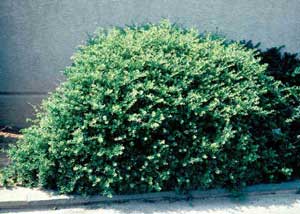Landscape Shrub
Dwarf Japanese Holly
(Ilex crenata 'Compacta')
If your house is less than 25 years old, you may have one or both of these hollies in a landscape bed around the foundation of your home. Japanese holly (Ilex crenata) and dwarf yaupon holly (Ilex vomitoria ‘Nana’ and similar cultivars) are favorite broadleaf evergreen shrubs for foundation beds throughout the South.
From a distance, Japanese holly and dwarf yaupon holly appear almost identical. Only subtle differences can separate these two distinct species. While very subtle differences in the serration (teeth) along the leaf margin can be used, a person can typically tell these species apart by looking at the young twigs. Twigs on Japanese holly are almost always green on the young shoots, while young twigs on yaupon holly will either be a purplish or gray color depending on the cultivar and time of year.
What are the characteristics of the Dwarf Japanese Holly? How is it different from the Dwarf Yaupon Holly?
Fruit color is the most reliable trait to separate these species, however. These hollies are dioecious, so an individual plant is either a male or female. Fruits on female yaupon holly are a beautiful red, in contrast to the shiny black fruits of Japanese holly. Fruits on both are pea-sized (1/4”) and usually persist into the winter. Typically the beautiful red fruits on dwarf yaupon holly (and most female cultivars) do not have the same dramatic effect as we see in weeping yaupon holly (Ilex vomitoria ‘Pendula’).
In general, the fruit on either of these holly species will not add greatly to your landscape. The flowers also make little or no contribution. Flowers on either species are very small and white. Yaupon holly should flower before Japanese holly.
What are some of the uses of hollies in the landscape?
The reason for planting either of these evergreen hollies is for the useful plant habit. There are many selections of either species which make great options in a foundation planting, as a mass planting in an island bed, or as a low filler plant in a mixed shrub border. Some good, mounded selections of Japanese holly include ‘Compacta,’ ‘Convexa,’ ‘Helleri,’ ‘Hoogendorn,’ and ‘Soft Touch.’ ‘Convexa’ is easily identified since you can see the ‘convex’ (cupping down) nature of the leaves so easily. ‘Helleri’ is a choice form because it has an excellent and distinctive habit without pruning.
Are there cultivars with similar plant habits?
If you are looking for similar plant habits in the dwarf yaupon holly group, consider one of the following cultivars: BordeauxTM, ‘Nana,’ and ‘Schillings’ (‘Stokes Dwarf’). Most of these mounded types will average 2’ tall with a width of 4’–5’. Gardeners in the northwest part of Arkansas may want to stick with Japanese holly, which in theory is more cold hardy; gardeners in central and southern Arkansas may prefer yaupon hollies, which tend to be more heat tolerant.
Both of these species offer a unique, pencil-thin upright form. ‘Sky Pencil’ is the Japanese holly version of ‘Will Fleming’ yaupon holly.
For either of these species, good soil drainage is critical. The most common reason for death with these plants is heavy, wet soil, often found in compacted sites after new construction. Besides this specific soil requirement, it is rare to see a serious insect or disease problem on either of these species.
You will enjoy the very clean, small, evergreen foliage of either of these plants. If you can avoid the temptation, keep your hedge shears away from these delightful mounded cultivars.
- Common Name: Japanese holly, yaupon holly
- Varieties to look for: ‘Compacta,’ ‘Helleri,’ BordeauxTM, ‘Nana,’ and ‘Schillings’
- Flower Color: white, but not showy
- Blooming period: early summer, spring
- Perennial or annual: broadleaf evergreen shrub
- Size: 2’ tall by 5’ wide
- Exposure: partial sun to sun
- Soil: demand good drainage
- Watering: moist best
- When to prune: anytime
- Suggested use: massed, filler, low hedge
Form
